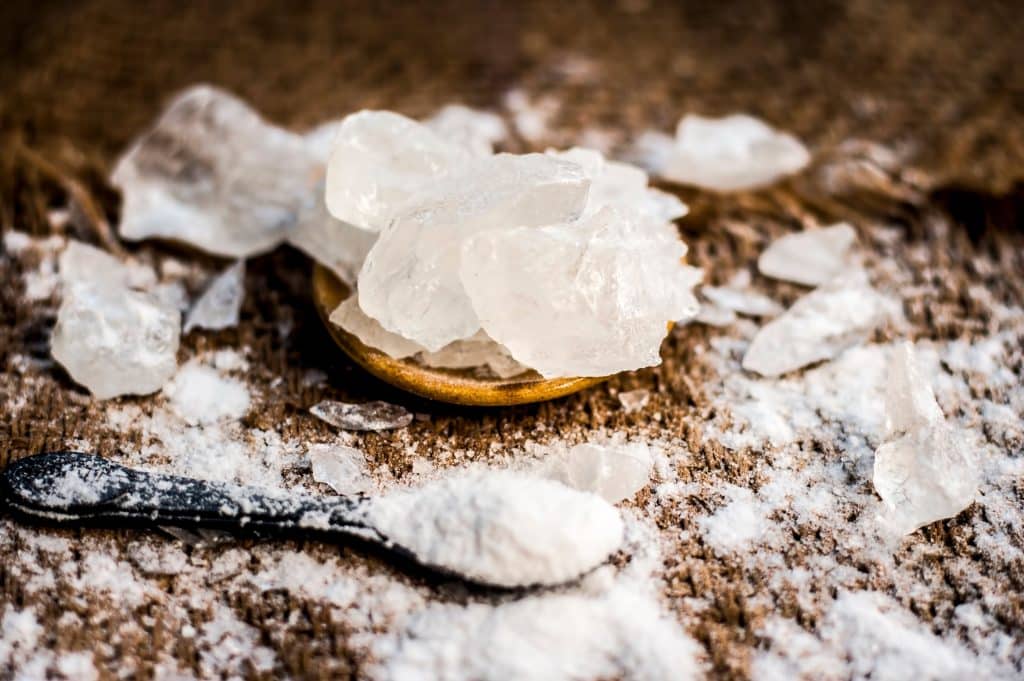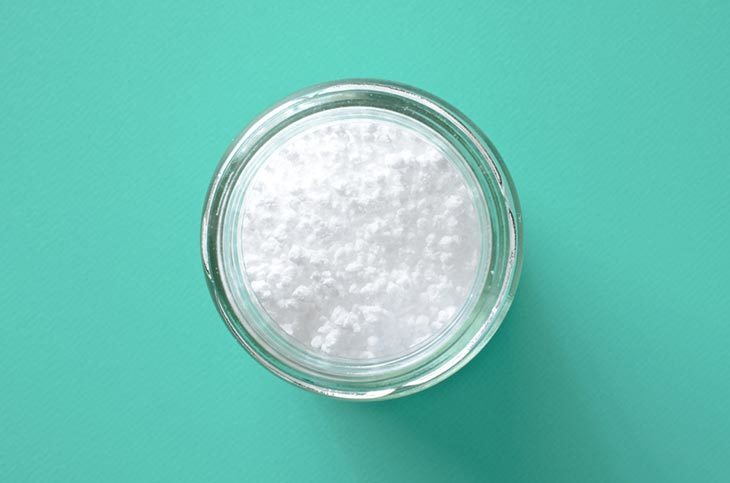10 Best Alum Substitutes
With such wide uses, alum seems to be an irreplaceable ingredient. However, if you run out of alum, is there any other choice that can substitute it?
The answer is YES. Let’s dive deep into the top 10 alum substitutes and find out their function.

What Is Alum and How Does It Taste?
What is an alum? By scientific definition, alum is the chemical substance with the formula KAl(SO4)2·12H2O. Typically, the alum used in cooking is potassium type.
We can find alum in various forms: crystalline, powder, or hard rock. Based on your need, you can choose the appropriate form of alum to use.
For kitchen purposes, alum comes with the white powder form. What does alum taste like? Well, this ingredient is used for pickling and baking purposes. The alum, of course, provides the acidic flavor. Besides, there is one distinctive taste you could find in the alum: astringent. In terms of texture, alum is colorless, odorless, and soluble in hot water.
That is all the information you need to know about alum. Scroll down to the next segment to know more about some best alum substitutes.
What Are The Top 10 Alum Substitutes?

1. Lime
The first option on the list is lime. Traditionally, lime is widely used worldwide as a firming agent. You can find it mostly in cucumber, tomatoes, and melon pickling dishes.
The lime extract contains a high amount of calcium oxide, which will absorb slowly into the vegetables’ tissue to form the calcium pectate to keep pickles firm. That is how the lime works in pickles.
That being said, you can use lime interchangeably with pickling alum powder to preserve food and keep vegetables firm and fresh.
2. Horseradish
What is horseradish, anyway? Horseradish, or Armoracia rusticana, is a perennial plant originating from the Brassicaceae family clan. It comes from the same “family” of mustard, wasabi, cabbage, radish, and broccoli. Hence, horseradish has a similar taste to its “brother” – spicy, pungent, astringent, and strong herb aroma.
People prefer using horseradish in pickling recipes because of its softening function. To be more specific, the horseradish’s pungency, when fermented with vegetables such as peppercorns, zucchini, bell peppers, etc., will blend in well with the mix and raise the bitterness yet acidic of the pickling dish.
Based on our experience, the horseradish is only suitable for fermented, old pickles only. For newly-made ones, the strong mustardy flavor and pungent smell will shock you at first.
3. Herbs
It may sound weird, but in fact, you can use herbs to alternate the alum powder uses in food. Such a mind-blowing fact, right?
Pickling food demands acidity to restrain the growth of some harmful, food-borne microorganisms. Typically, these acids can be found in vinegar, lime, lemon juice, or citrus fruits.
Surprisingly, that acid can also be composed through the fermentation process of lactic acid bacteria, which live naturally on some herbs like cabbage leaves, cilantro, bay leaf, cinnamon, or nutmeg. In other words, some herbs mentioned above can accelerate the procedure of keeping the pickles firm, crispy, and edible.
4. Vinegar
Vinegar is popular in many cooking recipes. It has a strong acidic taste with an intense, unique smell.
The vinegar is sour and can lengthen the shelf life of vegetables in pickling dishes. It also promotes the firming process to make pickles crispy and thick.
So, compared to the alum, how compatible is vinegar? In our opinion, alum is a chemical substance specifically manufactured for pickling purposes, so its effect is, of course, stronger than the natural source – vinegar. If you use a milligram of alum, then add two teaspoons of vinegar instead.
5. Lemon Juice
Lemon juice, just like vinegar, is a famous acid that can replace alum uses in cooking, especially in pickling dishes. The lemon juice provides a sour, citrusy taste that works well in fermenting.
People usually confuse lemon juice and vinegar. To be more specific, how to know when you should use the lemon and when to choose the vinegar?
Well, the lemon juice is a citric acid mixture with only 5-6 percent of the citric acid root.
Meanwhile, vinegar is the acetic acid with a higher percentage of sourness substance. There is about 7 percent of acid for the white vinegar, while it is about 5 to 6 percent of acetic acid.
Given these facts, the vinegar seems to have a higher acidity level than the lemon juice. So, the lemon juice, with its acid component, can work well as a firming agent in pickling, replacing the alum, but the intensity is lower than vinegar.
6. Tartar Cream (Best choice)
Among those options on the list, tartar cream is the best choice if you are asking us to select one candidate for the question of what is a substitute for alum. Let us explain how similar they are!
Regarding the taste, tartar cream is acidic, just exactly like the alum. For a long time, people have used tartar cream as a leavening agent in baking. When reacting with baking soda, the tartar cream will keep the dough leaven for a longer time normal. It also retains the gas inside the dough, making the dough rise as demanded.
You may question why we mention the leaving effect of the tartar cream in this post? Well, the tartar cream works best in that function, and alum is used for that purpose, too! The taste is similar, and the function is also exactly the same – tartar cream is absolutely the best substitute for alum baking powder, right?
7. Oak Leaves
You can use oak leaves to substitute the position of alum in pickles. More specifically, the acidic herbs, like horseradish, sour cherry, oak, grape, etc., contain tannin. And you know what tannin is? It is the substance that creates and boosts the phenol compounds to keep vegetables crisp!
Isn’t “keeping the plant crisp” the function of alum in pickling? Then, if the leaves can provide such tannin amount and offer a similar ability to pickling as alum did, it can be a substitute, right? Let us tell you one point: among the acidic herbs mentioned above, the oak leaves contain the most tannin.
Therefore, the oak leaf is a great choice when considering substitutes for alum. We advise that the ratio is about one tablespoon of alum to 3 leaves of the oak tree.
8. Sour Cherry Leaves
Like the oak leaf, the sour cherry leaf is an acidic plant containing a high amount of tannin. Thus, the cherry leaves can keep the pickles firm and crispy, just like what we demand from alum in cooking.
Compared to the oak leaves, sour cherry leaves’ effect in pickling is lower. It contains a little amount of tannin, so this point is understandable, right?
What about the sour cherry leaves’ flavor? Here is an interesting point: despite the name, cherry leaves taste bitter and acidic, but the bitterness overshadows.
9. Ascorbic Acid
Ascorbic acid, or vitamin C, is a water-soluble natural substance. You can find it in citrus fruits (lemon, lime, orange, etc.). With a high acidity like vinegar and lemon juice, the ascorbic acid can work well as an alum powder substitute.
To be more specific, the ascorbic acid, when mixed with the yeast in bread, will accelerate the leavening effect of the yeast. Thus, if you add more ascorbic acid to the dough, the loaf volume will rise much better. As mentioned above, the alum is used for this function, too. So, the alum and ascorbic are alterable, right?
10. Calcium Hydroxide
Calcium hydroxide is the legend, the classic ingredient to make pickles. This is the most common choice when it comes to cucumber and tomato pickling recipes.
In particular, the calcium hydroxide has the chemical formula Ca(OH)₂. With the (OH) root, the calcium hydroxide is a base, not an acid. This substance, if blended in pickles, will drop the general pH of the food and make it less acidic.
So, can calcium hydroxide become a substitute for alum powder? The answer is a big YES. If you question, “How can a base replace an acid?” then here is the explanation.
The Ca(OH)₂ can react to the pectin in fruits and vegetables, forming the calcium pectate and keeping the fruits firm. That is what the alum does, too. So, in terms of firming the pickles, we can use alum and calcium hydroxide interchangeably.